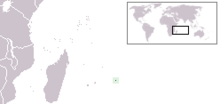| Newton's parakeet | |
|---|---|

| |
| Life drawing by Paul Jossigny, 1770s | |
| Scientific classification | |
| Domain: | Eukaryota |
| Kingdom: | Animalia |
| Phylum: | Chordata |
| Class: | Aves |
| Order: | Psittaciformes |
| Family: | Psittaculidae |
| Genus: | Psittacula |
| Species: | †P. exsul
|
| Binomial name | |
| †Psittacula exsul (Newton, 1872)
| |

| |
| Location of Rodrigues | |
| Synonyms | |
| |
Newton's parakeet (Psittacula exsul), also known as the Rodrigues parakeet or Rodrigues ring-necked parakeet, is an extinct species of parrot that was endemic to the Mascarene island of Rodrigues in the western Indian Ocean. Several of its features diverged from related species, indicating long-term isolation on Rodrigues and subsequent adaptation. The rose-ringed parakeet of the same genus is a close relative and probable ancestor. Newton's parakeet may itself have been ancestral to the endemic parakeets of nearby Mauritius and Réunion.
Around 40 centimetres (16 in) long, Newton's parakeet was roughly the size of a rose-ringed parakeet. Its plumage was mostly greyish or slate blue in colour, which is unusual in Psittacula, a genus containing mostly green species. The male had stronger colours than the female and possessed a reddish instead of black beak, but details of a mature male's appearance are uncertain; only one male specimen is known, and it is believed to be immature. Mature males might have possessed red patches on the wing like the related Alexandrine parakeet. Both sexes had a black collar running from the chin to the nape, but this was clearer in the male. The legs were grey and the iris yellow. Some 17th-century accounts indicate that some members of the species were green, which would suggest that both blue and green colour morphs occurred, but no definitive explanation exists for these reports. Little is known about its behaviour in life, but it may have fed on the nuts of the bois d'olive tree, along with leaves. It was very tame and was able to mimic speech.
Newton's parakeet was first written about by the French Huguenot François Leguat in 1708 and was only mentioned a few times by other writers afterwards. The specific name "exsul" is a reference to Leguat, who was exiled from France. Only two life drawings exist, both of a single specimen held in captivity in the 1770s. The species was scientifically described in 1872, with a female specimen as the holotype. A male, the last specimen recorded, was collected in 1875, and these two specimens are the only ones that exist today. The bird became scarce due to deforestation and perhaps hunting, but it was thought to have been finally wiped out by a series of cyclones and storms that hit Rodrigues in the late 19th century. Speculation about the possible survival of the species, though unfounded, lasted as late as 1967.
- ^ BirdLife International (2016). "Alexandrinus exsul". IUCN Red List of Threatened Species. 2016: e.T22685465A93074571. doi:10.2305/IUCN.UK.2016-3.RLTS.T22685465A93074571.en.
